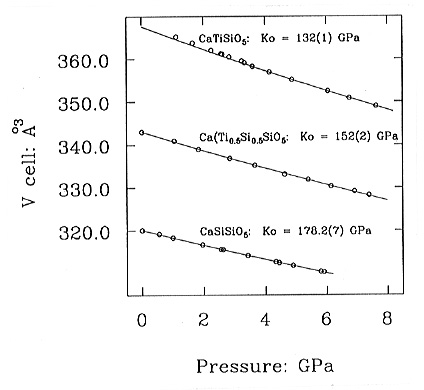

Isovalent substitutions of octahedral cations, such as Fe2+ for Mg2+, in minerals usually have a relatively small effect on the bulk moduli. However, determinations of the effect of similar isovalent substitution mechanisms involving octahedral silicon, which might be important at mantle pressures and especially in perovskites of the lower mantle, have been hampered by a lack of samples. Existing data on the effect of the exchange of Si and Ti in Ca(Ti,Si)O3 perovskites suggest that, despite the presence of structural phase transitions, the order of the induced change in bulk modulus for complete exchange of Si for Ti remains around 10-20%. The recent discovery of a titanite-structured phase of CaSiVISiIVO5 (see 3.3f this Annual Report), and a complete solid solution between it and titanite, CaTiVISiIVO5, at high temperatures and pressures provides another opportunity to examine the effect of a Si for Ti exchange on the elasticity of solids.
The variation with pressure of the unit-cell volumes of CaTiSiO5 and Ca(Ti0.5Si0.5)SiO5 were measured by X-ray powder diffraction at the ESRF, Grenoble. The ESRF synchrotron source provides on beamline ID30 a monochromatic X-ray beam of sufficiently high intensity that diffraction patterns from powders held at pressures inside diamond cells can be collected in times of about 10-15 minutes. Both samples were studied to a maximum pressure of ~8 GPa. In addition to measuring its equation of state, the P21/a to A2/a phase transition in CaTiSiO5 was located at 3.6 GPa and shown to be second-order in character. Data for CaSi2O5 were collected from a single crystal with the Huber diffractometer in Bayreuth, previously described in the Annual Reports of 1995 and 1996.
Equation of state parameters for the three compositions were determined
from the volume-pressure data measured in the diffraction experiments.
In the A2/a phase of all three samples (above 3.6 GPa for CaTiSiO5,
above 0.2 GPa for CaSi2O5 (section 3.3f), at all
pressures for Ca(Ti0.5Si0.5)SiO5) the
pressure derivative K' of the bulk modulus does not differ significantly
from 4. The bulk moduli (K0T) obtained from fits of a Birch-Murnaghan
EoS with K' = 4 are given in Fig. 3.3-9. The ~47 GPa (30%) increase in
bulk modulus arising from the complete substitution of Si for Ti is far
in excess of the 13% expected from density - bulk modulus systematics and
indicates that partial substitution of Si for other octahedral cations
in high-pressure phases minerals might have large and unexpected effects
on the elasticity of mantle minerals.
 |
|

Tel: +49-(0) 921 55 3700 / 3766, Fax: +49-(0) 921 55 3769, E-mail: bayerisches.geoinstitut(at)uni-bayreuth.de
 Previous page
Previous page